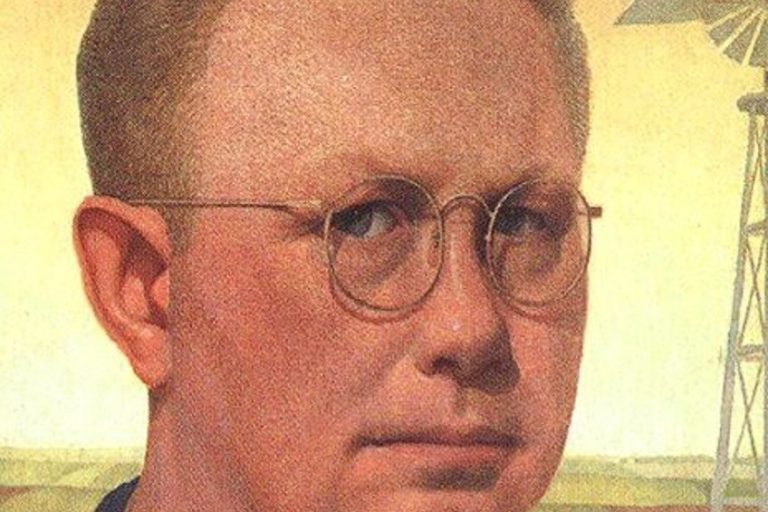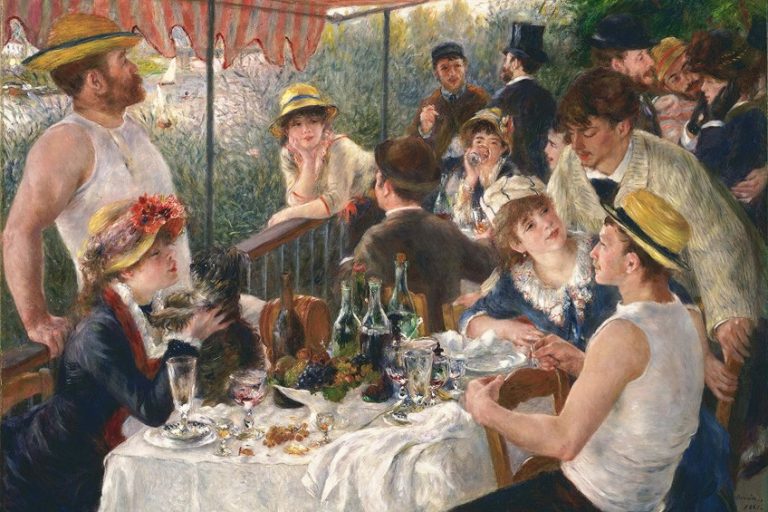Yoko Ono’s Art – Pushing the Boundaries of Conceptual Art
Yoko Ono, a pioneering figure in conceptual and performance art, has left an indelible mark on the art world with her thought-provoking and boundary-pushing creations. Born in Tokyo, Japan, in 1933, Ono’s multifaceted artistic career spans decades and encompasses a wide range of mediums, including installations, films, music, and writings. A prominent voice in the avant-garde movement, her work often explores themes of peace, feminism, and human connection, challenging traditional notions of art and inviting viewers to engage with profound ideas and experiences. From her iconic collaborations with John Lennon to her innovative solo projects, Yoko Ono continues to inspire and provoke contemplation through her artistic vision and fearless creativity.
Table of Contents
Key Takeaways
- Yoko Ono’s work bridges various artistic disciplines and carries a strong message of peace and activism.
- Her contributions to the avant-garde art movement have been characterized by participatory and performance elements.
- Ono’s legacy in art continues to influence new generations, highlighting the profound impact of her career and ideas.
Yoko Ono’s Art of Defiance
Yoko Ono is a multifaceted artist whose work transcends conventional boundaries and challenges traditional art forms. Born in Tokyo in 1933 and having moved to New York City in the 1950s, Ono has been a significant figure in the avant-garde art scene. Her art, imbued with elements of conceptualism, performance, and filmmaking, often incorporates themes of peace. Ono’s art consistently challenges societal norms and conventions, reflecting her unique perspective on truth and art. Her work often intersects with activism, inviting viewers to consider deeper political and social messages.
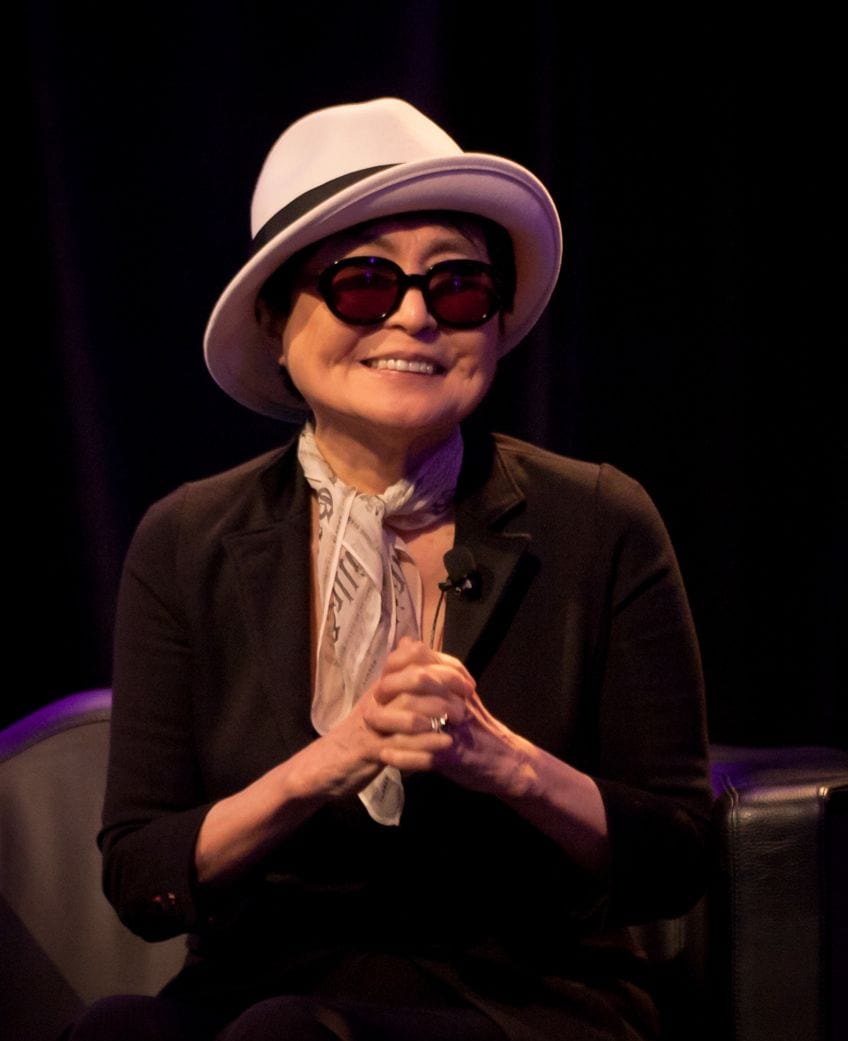
Renowned for her pioneering spirit in performance art and her marriage to Beatles member John Lennon, Ono continues to capture the imagination of audiences with her thought-provoking pieces. Ono’s influence in the art world is characterized by her defiance of expectations and her commitment to social engagement through her works. Her installations and performances often invite audience participation, blurring the lines between artist and observer. With a career that has spanned over several decades, Ono has consistently redefined her artistic style, from her early provocative displays in the 1960s to her later contributions to music and literature. She has conducted daring experimental art with a focus on subverting preconceptions and advocating for global peace.
Early Life and Influences
Yoko Ono was born in Tokyo in 1933 into a wealthy banking family. She experienced the horrors of World War II firsthand, an ordeal that would leave a lasting imprint on her psyche and later on her art. Ono’s early exposure to the violence of war informed her pacifist outlook which became a recurring theme in her work. In the 1950s, she moved to New York City and became involved in its avant-garde art scene, finding inspiration among fellow artists and intellectuals who were pushing the boundaries of contemporary art. Her works often blur the lines between art and activism, making profound statements on human rights, peace, and feminism.
Throughout her career, Ono has utilized performance, instructions, and participatory art to engage with the public, thus defying traditional notions of what art is and can be.
Evolution of Artistic Style
Yoko Ono’s artistic style has continually evolved, marked by her deep involvement in Conceptual Art, Performance Art, and Participatory Art, through which she has explored avant-garde ideas and challenged traditional art forms.

Conceptual Art
Ono emerged as a pivotal figure in the Conceptual Art movement of the 1960s, creating works that emphasized the importance of ideas over visual aesthetics. Her Painting to Be Stepped On invites viewers to participate in the artwork by stepping on a canvas, thus dematerializing the art object and focusing on the concept.
Ono’s “Instructions”—written directions for creating art—exemplify the core of Conceptual Art by suggesting that the idea behind an artwork can be as significant as the finished piece itself.
Performance Art
Ono’s forays into Performance Art have been characterized by their boldness and innovation. The seminal Cut Piece performance from 1964 epitomized her avant-garde approach, where audience members were invited to cut pieces of her clothing while she remained passive. This powerful act of vulnerability and trust created a dynamic interaction between the artist and participants, delving into themes of society, gender, and identity.

Participatory Art
The Participatory Art aspect of Ono’s work offers a platform for audience involvement, reflecting her belief in the democratization of art-making. Works like Wish Tree – where people are encouraged to hang written wishes on a living tree – and White Chess Set, designed to neutralize competition by making it hard to distinguish the players’ moves, employ a participatory element that blurs the lines between the artist, the artwork, and the viewer.
By engaging the public directly, Ono transforms passive viewership into active engagement, thereby reshaping the relationship between art and audience.
Yoko Ono’s Top 5 Artworks
Yoko Ono has produced a multitude of influential artworks spanning various media and methods. This section explores five of her most impactful pieces, which exemplify her innovative approach and the powerful messages embedded within her work.

Cut Piece (1964)
Cut Piece is a performance art piece that challenges notions of power, vulnerability, and audience participation. In this work, Ono sits still on stage while audience members are invited to approach and cut pieces of her clothing. The act of cutting away layers of fabric symbolizes the stripping away of social constructs and the exposure of raw humanity.
Through Cut Piece, Ono confronts issues of agency, consent, and the dynamics of control, sparking discussions about identity, agency, and the boundaries between self and society.

Grapefruit (Instructions) (1964)
Grapefruit is a collection of conceptual art pieces by Yoko Ono that blur the lines between art and everyday life. Each instruction within the book presents a simple yet profound action or thought experiment, encouraging readers to engage in creative interpretations and introspection.
By inviting individuals to participate in the creation of art through their own experiences and interpretations, Grapefruit challenges traditional notions of authorship and expands the possibilities of artistic expression beyond physical objects.
Bed-In (1969)
Bed-In was a series of nonviolent protests organized by Yoko Ono and John Lennon in 1969. By staying in bed for days at a time in various locations, the couple sought to promote peace and raise awareness about global issues. This performance art piece became a symbol of peaceful resistance, attracting media attention and sparking conversations about activism, celebrity influence, and the power of collective action.
Bed-In highlighted the intersection of art, politics, and social change, embodying Ono and Lennon’s commitment to using their platform for positive impact.
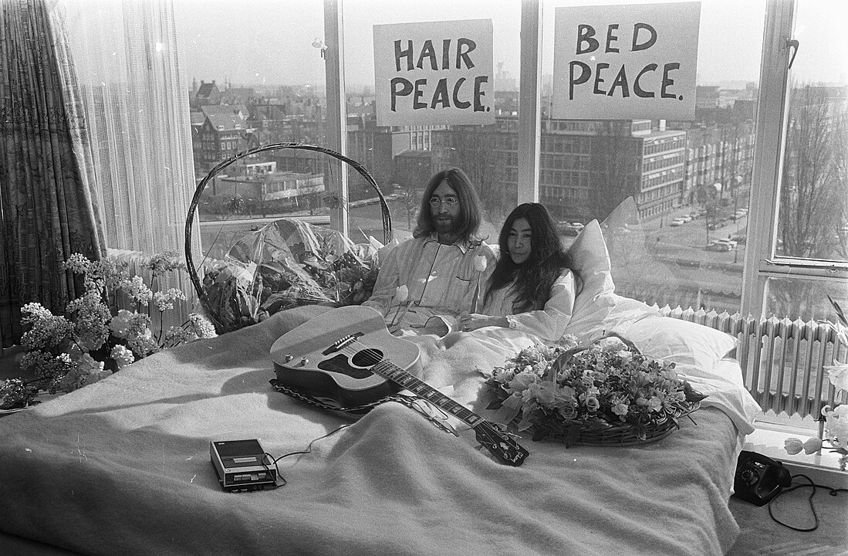
Wish Tree (1993 – Present)
The ongoing Wish Tree installations invite viewers to write their wishes on pieces of paper and tie them to the branches of a tree. The concept of collective wishing and sharing hopes for the future symbolizes unity, hope, and the human desire for connection and understanding.
Over the years, Wish Tree has been exhibited in various locations worldwide, fostering a sense of community and encouraging contemplation about our shared aspirations and dreams as a global society.

Imagine Peace Tower (2007)
Yoko Ono’s Imagine Peace Tower is an art installation in memory of John Lennon. Located in Iceland, the tower emits a beam of light into the sky, inscribed with the words “Imagine Peace” in multiple languages. This monumental artwork serves as a beacon of peace and unity, inviting people from around the world to reflect on Lennon’s vision of a harmonious planet free from conflict.
The Imagine Peace Tower continues to illuminate the night sky, reminding us of the enduring power of art to inspire hope and promote messages of peace.

Activism and the Quest for Peace
Yoko Ono, long recognized as an avant-garde artist and musician, has intertwined her creative endeavors with a steadfast commitment to activism, particularly in the pursuit of world peace. Her marriage to John Lennon amplified their mutual advocacy, channeling the power of their public personas into a resonant message of harmony. One of Ono’s and Lennon’s most iconic acts of peaceful protest was the Bed-In event, held in hotel rooms in Amsterdam and Montreal in 1969. These events were designed as non-violent protests against war and a means to promote peace. In addition to her events and installations, Ono’s influence extended into music.
The song Imagine, co-authored with Lennon, remains a poignant anthem advocating for peace. Its lyrics encapsulate Ono’s and Lennon’s dream of a harmonious world free of division.
Ono’s activism wasn’t confined to any single region. She influenced both the US and UK cultural landscapes. Her art exhibitions and peace initiatives have taken place in cities like London and Manhattan, reverberating her message across the globe. Yoko Ono’s pursuit of peace through activism, music, and interactive art events underscores her unwavering dedication to this cause. Her works challenge individuals to consider their role in fostering peace, encouraging not just contemplation but active participation in the quest for a peaceful world.
Cultural and Artistic Impact
Yoko Ono’s contributions to contemporary art have been multifaceted, influencing not only the realms of performance and installations but also the intersection of art and music. As a key figure associated with the Fluxus movement, Ono’s works were grounded in a philosophy that art should be an interactive experience, challenging traditional boundaries between the artwork and the audience.
Ono’s art has been displayed in prestigious venues, including the Museum of Modern Art (MoMA) and Tate Modern, asserting her significance in the feminist and contemporary art narratives. Her exhibitions tend to engage individuals on a personal level, often through immersive and participatory experiences. Her pieces offer reflections on the female experience, bringing feminist topics to the forefront of artistic discourse.
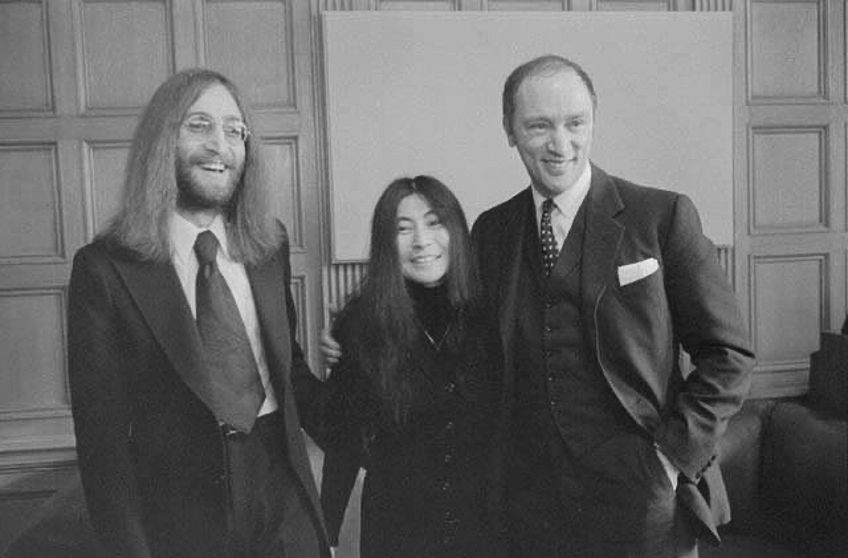
Ono’s performance art, notorious for its radical approaches, invites the audience to become part of the art itself, thus breaking down the conventional passive viewing experience typical of a traditional gallery setting. As a musician, her concerts often blur the lines between music and live art, demonstrating a synergetic relationship between these mediums. Her work is deeply philosophical, prompting viewers to reconsider the nature of art. This is exemplified by her well-known instruction pieces, where the act of imagination is as valued as a physical creation. Ono has undoubtedly paved the way for performance artists and musicians, encouraging them to see art as an opportunity for radical personal expression and societal commentary.
Her influence continues to resonate in diverse areas of culture, validating her position as a pivotal figure in the evolution of conceptual and performance art.
Legacy of Yoko Ono’s Art
Yoko Ono’s art has left an indelible mark on the avant-garde scene, resonating with audiences worldwide and influencing generations of artists. Her works, often challenging and innovative, confront traditional boundaries and explore themes of peace, love, and human interaction. Yoko Ono continues to be celebrated as a pioneering figure in the art world. Her exhibitions feature a diverse range of mediums, including performance, music, and installations that invite audience participation.

Even decades after her initial foray into the art scene, she remains a relevant and thought-provoking artist. Her legacy is not just rooted in her past works but is also defined by the ongoing impact of her art, which encourages viewers to reflect on social issues and their role within them. The reach of Ono’s art transcends generations and continues to evolve, ensuring that her contributions to culture and art are enduring and dynamic.
Yoko Ono’s artistic legacy is one of innovation, activism, and relentless exploration. Throughout her career, she has pushed the boundaries of art, challenging conventional norms and inviting audiences to rethink the possibilities of creativity. From her early conceptual works to her ongoing commitment to promoting peace and social change, Ono’s art has left a lasting impact on the global art scene. Her ability to blend personal expression with universal themes has resonated with generations of artists and viewers alike, making her a trailblazer in the realms of conceptual and performance art. As we reflect on her contributions, it becomes clear that Yoko Ono’s art is not just a reflection of her time but a timeless beacon of inspiration and aspiration for a better world.
Frequently Asked Questions
How Has Yoko Ono’s Background Influenced Her Artistic Expression?
Yoko Ono’s artistic expression is deeply rooted in her experiences, particularly her survival of the bombings of Tokyo, her engagement with various cultural movements, and her own philosophical inquiries. This confluence of personal history and cultural engagement informs her unique conceptual and performance art pieces.
What Are the Key Characteristics of Yoko Ono’s Performance Art?
Her performance art is marked by its avant-garde nature and interactive engagement with the audience. Incorporating simple actions, instructional pieces, and use of everyday objects, Ono invites participants to become part of the art itself, challenging traditional concepts of art and its creation.
How Did Yoko Ono’s Work Contribute to the Fluxus Art Movement?
Yoko Ono was a significant figure in the Fluxus movement, a collective that valued simplicity and anti-commercialism. Through her groundbreaking exhibitions and thought-provoking performance pieces, Ono embodied the Fluxus ethos of blending different artistic media and disciplines and emphasizing the artistic process over the finished product.
What Thematic Elements Are Commonly Found in Yoko Ono’s Artworks?
Themes of peace, feminism, and self-reflection frequently surface in Ono’s work. She often uses art to address social and political issues, promoting a message of unity and personal introspection, while consistently challenging audiences to question their perceptions and assumptions about art and life.
Isabella studied at the University of Cape Town in South Africa and graduated with a Bachelor of Arts majoring in English Literature & Language and Psychology. Throughout her undergraduate years, she took Art History as an additional subject and absolutely loved it. Building on from her art history knowledge that began in high school, art has always been a particular area of fascination for her. From learning about artworks previously unknown to her, or sharpening her existing understanding of specific works, the ability to continue learning within this interesting sphere excites her greatly.
Her focal points of interest in art history encompass profiling specific artists and art movements, as it is these areas where she is able to really dig deep into the rich narrative of the art world. Additionally, she particularly enjoys exploring the different artistic styles of the 20th century, as well as the important impact that female artists have had on the development of art history.
Learn more about Isabella Meyer and the Art in Context Team.
Cite this Article
Isabella, Meyer, “Yoko Ono’s Art – Pushing the Boundaries of Conceptual Art.” Art in Context. April 2, 2024. URL: https://artincontext.org/yoko-onos-art/
Meyer, I. (2024, 2 April). Yoko Ono’s Art – Pushing the Boundaries of Conceptual Art. Art in Context. https://artincontext.org/yoko-onos-art/
Meyer, Isabella. “Yoko Ono’s Art – Pushing the Boundaries of Conceptual Art.” Art in Context, April 2, 2024. https://artincontext.org/yoko-onos-art/.





